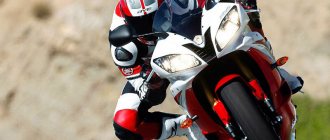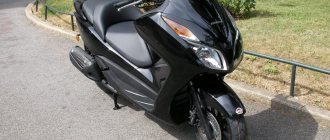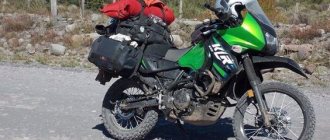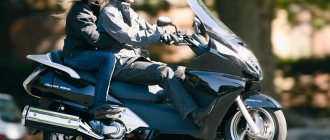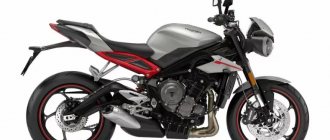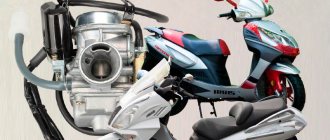Buying a motorcycle is a joyful event for a future biker.
But he should think about his protection and equipment. A helmet is the most important part of motorcycle equipment and should be purchased responsibly. It happens that a motorcyclist gets blindsided by the assortment presented in stores, and he gets confused about what kind of “germak” he needs. In the article we will give a number of tips for choosing that will definitely come in handy. Let's get started!
Deciding on the type
Motorcycle helmets are divided into five main groups:
- integral (“full face”). The most popular type, chosen by both ordinary motorcyclists and regulars of high-speed racing. It is a one-piece configuration that fully protects the pilot's head, with a visor. Each equipment brand produces integrals in different price categories. Additional options are also available: ventilation, cheek pads, breathing deflectors. Ideal for road users (CB 400, Bandit 250) and sports (Yamaha R6, Honda CBR 954rr).
- modular (“transformer”). The type where the visor - the visor and the chin part - rises up. It is taken by travelers on motorcycles due to its convenience: you can carry on a conversation, quench your thirst, etc. The disadvantages are increased weight and poor sound insulation. The protective properties are quite high. Suitable for motorcycle tourists (BMW R1200GS Adventure, KTM 1190 Adventure Honda NC750X)
- open (“3/4”). It is a regular motorcycle helmet with a large visor or visor, but without a visor. It has a reduced level of safety, as the product manufacturers warn about. The jaw will be the first to be damaged in a fall. It is bought by drivers of maxi-scooters (Yamaha Majesty250, BMW C 650 GT), regular scooters and mopeds (Suzuki Sepia 50, Honda Dio 50)
- half (“nut” or “helmet”). Covers only the top of the head, leaving the entire face and jaw exposed. It has low protective functions because it does not completely protect against the consequences of an impact. Despite the existing fastening, in the event of an accident it often flies off or rolls to one side. When traveling, it will not protect your face from flying gravel, dust, sand or insects. It happens that bikers complement the “nut” look with wide glasses with a thick elastic band. This model is sought after by chopper riders because it fits the motorcycle class (Shadow 400, Yamaha XVS 650, VTX 1800)
- motocross. The choice of every off-road vehicle fan: from ATVs to crossovers. Distinctive features: an extended forward visor that protects from dirt, splashes and tree branches, and a protruding jaw. The color is bright and noticeable. Motocross helmets also have an improved ventilation system to ensure good air flow. Ideal for tandem with an enduro motorcycle (Suzuki Djebel 200, KTM 500 XC-W, Yamaha TT-R 250).
Rating of the best helmets for motorcycles, scooters and ATVs
AGV Pista Gp R Agv Glossy Carbon
This helmet is completely professional equipment, since a multiple winner of motorcycle racing took part in its development. Testing also went through all the necessary procedures with the active assistance of participants in competitive races.
The equipment is completely enclosed, but the biker will appreciate the full viewing angle and good visibility. At the same time, protection of the biker’s skull bones is maintained even in the most extreme situations. The equipment is tightly and securely attached to the head, maintaining complete freedom of movement and without squeezing the blood flow. The manufacturer was meticulous in approaching the issue of safety; for this purpose, a special technology was developed, which has no analogues yet. The essence of this technology comes down to the competent distribution of impact force during a fall.
AGV Pista Gp R Agv Glossy Carbon
Advantages:
- responsible approach to the development and manufacture of goods;
- stylish design;
- many positive reviews;
- wide field of view;
- high quality and reliable design.
Flaws:
- high price.
The average cost is 75,000 Russian rubles.
ARAI QV-PRO GoldWing
Such equipment will become an indispensable assistant for a biker who prefers riding on city roads. The prototype of the model is the famous sports version of the helmet; thanks to this similarity, the product is very popular among racing fans.
The leading design feature is the ventilation system. It includes carefully designed channels and air intakes. To adjust the level of air circulation, the biker does not have to make any special efforts and remove protective gloves. A big advantage will be the glass, which prevents the user from being blinded by bright sunlight, and also maintains a wide field of view.
ARAI QV-PRO GoldWing
Advantages:
- high-quality construction;
- high level of security;
- protection from bright light;
- comfortable ventilation.
Flaws:
- fragility of additional elements;
- difficult to replace glass.
The average cost is 37,000 Russian rubles.
SHOEI GT-Air WANDERER2
If you are looking for the most comfortable model, this product will definitely interest you. The inner lining guarantees ease of use, protection from bright sunlight will protect the retina. In addition, there is excellent ventilation, which will be appreciated by bikers who spend a lot of time traveling.
The equipment is multifunctional, it can be used on an everyday basis, or you can safely wear it for extreme racing. The product is certified and fully complies with all international requirements. Particular attention should be paid to the case made using a special system. This technology includes a combination of carbon fibers. Thanks to this, you get a durable and impact-resistant design. The equipment is also easy to remove if necessary.
SHOEI GT-Air WANDERER2
Advantages:
- convenience and reliability;
- high quality at an affordable price;
- safety;
- excellent ventilation.
Flaws:
- heavy weight.
The average cost is 31,000 Russian rubles.
Shoei Neotec II
This product is ideal for tourist trips on a scooter without dangerous and sharp turns. The helmet is of the “modular” type.
This product is a redesigned version of the previous version, users have already appreciated all the changes. So what has changed in the product? Firstly, sound insulation due to the aerodynamic design of the helmet. Now the biker will feel as comfortable as possible at high speeds. Secondly, the adjustment of the seat straps has also changed for the better. And you can also forget about the strong pressure on your ears during overloads; the manufacturer has taken care of this problem as well. A special headset is built inside the helmet to prevent pressure. The body of the product is durable, it can compete in reliability with more expensive and equipped models. The glass can be lowered if necessary, and there is tinting to protect from the bright sun.
Shoei Neotec II
Advantages:
- noise suppression;
- headset that protects ears from pressure;
- durable body;
- reliable fasteners.
Flaws:
- It is difficult to replace elements and parts.
The average cost is 40,000 Russian rubles.
Shark Evo-One 2
A combined product that can transform from a fully closed helmet into an open and lightweight version. This feature is made possible by the fact that the front of the product slides backwards rather than upwards. This design, of course, is an advantage, but still has some inconveniences, so the closed version is more popular.
Manufacturing material – thermoplastic. That is why the model weighs little and does not hit the wallet too much. However, the shell strength is significantly lower, which makes the helmet unsuitable for dangerous racing with risky stunts. The glass is made to protect the eyes from bright light, in addition, the full viewing angle is maintained.
Shark Evo-One 2
Advantages:
- ease of use;
- low price;
- light weight;
- streamlined shape.
Flaws:
- undiversified size range;
- fragile body.
The average cost is 25,000 Russian rubles.
HJC IS-MAX II
The stylish helmet is made of durable materials, but its weight is a significant disadvantage - long trips can cause discomfort to your neck. Ventilation is also somewhat specific: for some it may not be enough, but for some bikers it is quite comfortable during long rides. The sun protection is of high quality, the glass moves easily and does not interfere with the viewing angle.
HJC IS-MAX II
Advantages:
- durable body;
- convenient design;
- stylish design.
Flaws:
- ventilation features;
- some elements are characterized by increased fragility;
- heavy weight.
The average cost is 11,000 Russian rubles.
FoxRacing V3 Preest LE
If you are looking for a product designed for racing, this model should suit you. The design is durable, the assembly is of high quality, the manufacturer has enough fans, including professional bikers and racers.
The case is made of materials that are resistant to shocks and falls, while the formation of cracks is minimal. The interior of the product is also designed to withstand the possibility of dangerous injuries. Ventilation is provided, it is convenient to use and allows air masses to circulate effectively. The field of view is quite wide, and the light weight of the product will protect the user’s back, neck and spine.
FoxRacing V3 Preest LE
Advantages:
- acceptable price;
- light weight;
- strength and reliability;
- regulation of additional elements;
- ventilation.
Flaws:
- fragility of additional elements.
The average cost is 25,000 Russian rubles.
From what materials?
This is an important design feature that affects the strength of this part of the equipment and the cost. There are two main groups of materials: composite and thermoplastic. Carbon is added to composite specimens, which provides less weight and increased impact resistance. The covering is made separately or in layers from fiberglass, carbon fiber and Kevlar. "Germak" made of thermoplastic is less durable and resistant to deformation, its weight is 300 grams more than the composite one, and the cost is significantly lower. But don't chase the low price. If a motorcycle helmet made of thermoplastic is not solid, it may break faster. Remember that the lighter the product, the less impact there is on the upper spine during an impact in an accident. A heavy “germak” made of thermoplastic will be inconvenient on a long trip or in tourist traffic. Experienced bikers know that spending money on a helmet made of composite material is completely worth it.
Checking the fit
- Let's look at the cheeks. Properly fitting the cheek pads tightly will slightly make you look like a hamster. If this effect is not noticed, a smaller size is most likely needed.
- Let's try to check it out. If you can do this, the helmet is great.
- We wear it for half an hour. During this time, you will feel whether this is your option or not. A snug fit is normal, but if you want to get rid of it faster, change the size. The main points of discomfort are the forehead and temples. If you notice a red “groove” on your forehead when you remove it, the model may not match the shape of your head.
- We are happy with the purchase and go for a ride. Of course, being in any helmet is not as comfortable as being without it. But if the choice is made correctly, after “breaking in” it will become “native” to you.
In conclusion, we can add that the helmet is a disposable product. It loses its effectiveness if it has “worked out” at least once and suffered a serious blow.
Don’t buy a helmet “for all occasions”; there is a reason why they are divided into types. Even its universal representative will not be good in different conditions.
Take your time, don’t skimp on yourself and your passenger. After all, you are choosing a piece of equipment that can save your life.
Buy by size!
Choosing the wrong equipment reduces all equipment protection to zero. An example that is too loose provides proper fixation and can shift position upon impact. Too narrow - it is inconvenient and will press.
The first step is to measure your head circumference above the ear with a measuring tape. Every more or less well-known manufacturer of motorcycle helmets has a sizing table. Note: the values in the table are different for each company; they do not coincide.
for example, the dimensional grid of the icon company:
Don't rush to go to the checkout and pay for your purchase. Calmly put on a motorcycle helmet and stay in it for 5-10 minutes, turn your head, tilt it in different directions, up and down. Jump on the spot several times to make sure that the purchase does not fly off or change position. It should not press hard or cause pain; the inner lining should gently fit the face. See if the view is wide and if objects from the side are clearly visible. When choosing between two pieces of different sizes, take the smaller one.
How to determine and choose a helmet size
If the helmet size is chosen correctly, it should fit like a glove without causing negative feelings. The first impression from the new helmet is that it is small. But wait a few minutes, during which time the flexible padding will mold to the shape of your head. If the helmet wobbles during sharp turns, head nods, or tips over when the strap is open, it is too big. When riding in such a helmet, the noise of the wind will be annoying, it will blow, and in the event of an accident it may simply fall off your head.
The size of the helmet often corresponds to the size of the hat. If you don't know your size, measure the perimeter of your head along the largest "cut" - above the eyebrows and ears. It may be necessary to take several measurements until the maximum is found. Unfortunately, many manufacturers have their own opinions regarding head size. For example, a size 62 helmet will be just right for someone wearing a size 59 headdress. You should not rely on designations such as “M” or “XL”. And helmets can be of different depths, so you still can’t do without trying them on.
Once the helmet is fitted, adjust the strap length. And always fasten your helmet, otherwise all discussions about safety will remain just discussions. Most helmet manufacturers recommend replacing the helmet every 2...4 years during normal use (a longer period applies to fiberglass products). If you find any damage to the helmet, do it early. In addition, all helmets are designed for only one accident - then they need to be replaced, but some motorcyclists repair their helmets.
Visor – window onto the road
When purchasing a model with a visor, this part must be inspected. Its presence is a guarantee of comfort, but it needs to be changed on time, otherwise chips and scratches will interfere with your view and distort the picture of the situation on the road. Helmet manufacturers offer replacement visors for sale. There are also glasses with different treatments: anti-fog, with protection against moisture, against chips and scratches. The age-old question - a regular visor or a tinted one? The tinted one will help out the pilot while driving on a sunny day when there are no sunglasses. But after twilight it will not provide adequate visibility on the highway. It makes more sense to purchase both options and change them depending on the situation.
Helmets for motorcycle tourism - a large review from RMT
For motorcyclists, issues of safety and comfort on a long journey are very important, so we want to talk about such an important element of protection as a helmet.
A motorcycle helmet is the piece of equipment that we use every time we get on a motorcycle. The head is the most important part of our body and choosing a comfortable and reliable helmet requires special attention.
The first thing to start with is that there is no ideal solution, since much depends on the country, traditions, climatic conditions, market, wealth and many other factors. For example, in Asia or California, where the climate is warm, Braincap or 3/4 type helmets are very popular, and in central or northern Europe with a cooler climate and high speeds on the autobahns, maximum protective integrals are used, but first things first.
Part one : types of motorcycle helmets
Open helmet, also known as Half Helmet , Open Helmet or “Half”. The simplest and least safe helmets, however, are very popular in Asia and among chopper riders, precisely where high speeds are not implied and rather leisurely driving in hot climates in cities or local roads is expected.
They are cheap, light, simple, and for fans of American cruisers, stylish. The safety of boilers is very conditional, although at “bicycle” speed they can save you from head injuries, and they also solve the problem with the law.
Also, due to its compactness, such a helmet can be placed in almost any bag or case and given to a passenger, if necessary, to give someone a ride. Also, such a helmet can be useful on a training site, when speeds are minimal and you need to hear the instructor well.
The 3/4 helmet, also known as Jet or Open Face , is already safer and classic Soviet motorcycle helmets belong to this type. They protect the entire head except the front part.
Their advantages include excellent visibility and ventilation, they are quite light, often have built-in sunglasses, and they are usually comfortable with simple glasses.
Now different manufacturers produce combined versions - with a detachable “jaw”, which is not much, but adds protection and makes riding more comfortable in cool weather. I call such variations Transformers or Crossover. In principle, this category also includes models of helmets in which the “jaw” folds back to the back of the head, turning it into an Open Face.
Integral or Full Face are considered the most protective helmets, naturally depending on the quality, thoughtful design and materials used. The design of the helmet is distinguished by a single layout of the head and jaw parts. This is probably the most popular type of helmet among motorcyclists (not to be confused with scooter riders in Asia), which arose in the wake of the popularity of sportbikes.
There are a huge number of models of integral helmets using different materials, shapes, types of air intakes and other features. There are very light models made of composite materials, with inflation systems for a tight fit of the inner upholstery, with special hyperallergenic materials and other features.
Well designed and made, this type of helmet truly protects the entire head and face and is the safest of all types of motorcycle helmets. However, certain disadvantages of this design can also be noted: you cannot drink or eat in such a helmet, it is difficult to talk with others, and it usually, but not always, has less visibility. It can also be noted that in hot weather and at low speeds it can be hot and stuffy.
Modular or Flip-up is a kind of intermediate option between an integral and a 3/4 helmet. Its special feature is the jaw part on a hinge, which, together with the visor, can be lifted up. When closed, it is close to an integral helmet - it has full protection of the head and front part.
This type of helmet also has its pros and cons. The advantages include convenience during short stops, when raising the “jaw” is very convenient to chat, drink water or have something quick to eat. Without taking off your helmet, it’s convenient to go to a gas station checkout or run into the bushes. The disadvantages include less safety, since the hinge joint is inferior to the integral in terms of impact resistance. Also, such helmets are heavier and noisier.
Cross and enduro helmets . This is a category of helmets, as the name suggests, for off-road riding on cross-country and enduro motorcycles. In essence, these are the same integrals, but as a rule, with an elongated chin part, with a visor and the absence of a visor, since special masks are used when driving on cross-country or enduro tracks.
However, now on the market there are models equipped with a quick-release visor, which can be unfastened and put on a mask - depending on the riding conditions, such helmets are called Dual Sport or dual-use helmets. These helmets are strong and reliable, but are poorly suited for high speeds.
Part two: helmets for motorcycle travel, choice and features
In the previous part we talked about what types of helmets there are, in this part we will talk about the most suitable helmets for motorcycle travel and their features.
According to our personal observations, the most common type of helmet among motorcycle travelers is the Modular/Flip-up; we constantly see them in our travels with “colleagues”, in reports, in articles about travel in motorcycle magazines, and of course, we ourselves ride in just such helmets.
There are no ideal things, but this design provides a compromise between protective properties, comfort and convenience. Very often, tourist modulars are equipped with a sun-protective retractable visor and visor, which is very helpful when driving in blinding sun conditions.
In such a helmet, by raising the “jaw”, you can talk, drink water, have a quick snack or meet other needs, since the view or tilt of the head down is practically unlimited.
Many touring motorcycles have good wind protection, so noise is not so critical, and with an open visor, the face is well aired, which is also important when traveling in hot climates.
Of course, such a helmet may lose to a good integral in case of a fall at speed or a collision, but still, a touring motorcycle is not a sportbike, and the age and road experience of motorcycle tourists are, as a rule, higher than those who like to ride around the city.
The second most popular type of helmet is classic integrals, which are also divided into sports, road and tourist models. They are popular with those who drive powerful touring cars and where speeds often exceed 150 mph. Or those who do not accept compromises in matters of security and are ready to sacrifice some conveniences for the sake of it. Also, integrals are lighter, they are less noisy and have a wide variety of models, which is also important for many!
And the third type of helmet that motorcycle travelers love is enduro helmets, especially the version with a removable visor.
Such helmets can often be seen on those who travel to hard-to-reach places with a lot of off-road use. They are quite light, with a high degree of safety, with good visibility, with a protective visor - just what you need outside the asphalt.
Now about the features of helmets and what you should pay attention to when choosing.
1. Shell shape
Our heads come in different shapes and sizes, and they can vary greatly. And if with the sizes everything is simpler - in the lines, as a rule, there are helmets from XS to XXL, then with the shape everything is more complicated.
As far as we know, only the Arai company produces lines of helmets for various head shapes, all the others specialize in a specific one. And, accordingly, you have to choose based on this parameter first of all.
If Shubert is not suitable for you, then Shoei or AGV may be suitable. And vice versa, for some people the Shubert fits perfectly and nothing else.
2. Dimensions
The helmet should not press too hard, let alone dangle. It should fit tightly on the head, without causing discomfort and without putting strong pressure on certain parts of the head. But we must take into account that the helmet upholstery wears out, shrinks a little, and the new helmet should be a little compressive, although this is a rather subjective parameter.
It is often recommended in a store to put on a helmet and walk around in it for 15-20 minutes to understand how well it fits your head and whether it will experience discomfort or pressure, for example, on the back of the head.
3. Fixation
There are three main types of chinstrap fastening used in motorcycle helmets.
The first is a quick-release fastener, used on scooters or very cheap Asian helmets. It is not reliable and there is no point in considering it.
The second is the D-Ring, a very old and proven type of fastener and it can be called the most reliable, since it has no mechanical parts. But at the same time, it is also the most inconvenient, since fastening such a helmet with gloves is very difficult and, in general, manipulating it takes time.
The third is micrometric fixation, which is both quite reliable and comfortable, and most branded helmets are produced with such a system. Another big plus is that you can quickly adjust the degree of belt tightening, albeit in a relatively small range.
The choice of fixation is a personal matter; we are proponents of micrometric fixation.
4. Visor, sunglasses and visor
The visor is a very important part of the helmet, since through it we look from the saddle of the motorcycle and must see everything clearly and clearly. The visor should not have optical distortion that affects your perception, it should be resistant to scuffing and scratching, and we strongly recommend choosing a helmet equipped with a Pinlock system. This is a transparent insert on the inside of the visor with a silicone gasket, making it an anti-fog glass unit, which is very helpful in cold and rainy weather and directly ensures your safety.
We also prefer only transparent visors, since various “mirror” coatings reduce visibility in the dark and can give stray reflections from flashlights and oncoming headlights.
The retractable sun visor is a very convenient thing for traveling. It helps out in bright sunshine, and in hot weather it allows you to open the main visor and at the same time protect your eyes both from the sun and from insects, dust or splashes. At the same time, it quickly extends/retracts and does not put pressure on the temples with the arms.
The visor is the main attribute of motocross helmets, which has also migrated to some touring models. With good wind protection, it does not cause any inconvenience even at speed, but it is very helpful when driving strictly in low-level sun, where a sun visor or dark glasses will not help.
You can tilt your head so that the visor blocks the sun and then, although not very comfortable, you can drive without being blinded. And the second important feature of a visor when traveling is that if you drop the helmet from a table or from the seat of a motorcycle, or simply drop it out of your hand, you can break the visor, but the visor itself will remain intact!
You won’t find a visor for your helmet anywhere except Moscow and some other big cities, and it’s not a fact that it will be in stock and not on order. And riding in a helmet, where there will be noticeable scratches in the middle of your field of vision, is very uncomfortable and unsafe.
5. Materials.
Any high-quality and certified helmet will perform its functions and materials are more likely to relate to the degree of comfort of a particular helmet. Polycarbonate, fiberglass or carbon fiber as the outer shell means weight. Internal upholstery – tactile sensations and comfort. Ventilation – comfort in hot climates.
You can also note options with built-in headsets, compartments inside for speakers and other little things, but these are not the most important things in the helmet, but rather pleasant additions.
Part three: Manufacturers and models of tourist helmets
Nowadays there are a large number of helmet manufacturers and there is no point in listing them all; we will only note the most famous and proven ones, dividing them into three groups.
1. Upper price segment, top helmets:
- Shubert - E1, C3, C4
- AGV - AX-8, AX-9
- Arai - Tour-X 4, QV-Pro
- Shoei - Hornet Adv, GT-Air II, Neotec II
- Klim — Krios
- Touratech - Aventuro
- BMW - GS, Motorrad System 7
2. Middle segment:
- Scorpion - ADX-1, Exo-Tech, Exo-920
- Airoh - Commander
- HJC - i-90, RPHA-90, C-70
- Nexx - X-Vilijord, X.Wed
- Nolan - N100, N40-5
- Caberg - Tourmax, Horus Scout
- Bell - MX9 Adventure MIPS, Revolver EVO
- Shark - EVO ES, Evojet
- LS-2 - Valiant II
3. Economy option
- LS-2 - Metro Evo
- THH - T797
- Bogotto - V331
- O'Neal - Sierra II
- GMax - GM54S
- Fly - Trekker
It is advisable to choose a helmet from well-known and reputable manufacturers. Must have European ECE 22.05 certification or American DOT certification (which is obsolete).
There are also optional SNELL and SHARP certifications, which can show the strengths and weaknesses of various models in their ratings.
It is worth noting that now even budget models fully meet safety requirements, and savings are achieved due to simpler design and quality of materials, which affects weight and ergonomics.
We will not recommend any specific helmet or brand, they are all good in their classes, see the helmet live, try, measure, buy what suits you best.
Questions, comments, suggestions, wishes, write to us at [email protected]
See you on the roads!
Motorcycle helmet color. Matte or glossy?
Many motorcyclists choose equipment that matches the color of the vehicle. But bright colors are safer: a pilot in such a “germak” will be visible on the road, even through several rows of traffic. Lighter shades accumulate less solar heat, making driving easier on a hot day.
As for whether to choose a matte or glossy finish, this is a purely aesthetic question. Note that dirt, fingerprints and dust are more visible on the matte model.
4.Buy a helmet from a friend
A helmet is a personal protective equipment. Each motorcyclist chooses a helmet according to his anatomical features and preferences. A friend chose a helmet for themselves, so you choose a helmet that suits you.
When you try on another person’s helmet, you don’t think that the lining has changed the shape of the owner’s head during wear, and when you order a new one, you are surprised at how tightly the helmet fits.
“How not to choose equipment?”
Decorative devices – are they necessary?
The desire to stand out on the road and in the motorcycle crowd pushes bikers and passengers to think about decorative overlays on their helmets: various dreadlocks (in the Predator style), bright braids for girls, cat “ears” and so on. The traffic rules do not prohibit such “improvements”, but from a technical point of view they are not safe. Dreadlocks and braids can get caught while driving or in an accident. When driving at a certain speed, cat “ears” begin to tilt their head back, which causes great inconvenience to the owner. Yes, you can please yourself with such new products, but at themed events, and driving on public roads in such is undesirable.
What is a helmet for?
One of the reasons for purchasing a scooter is the feeling of independence of riding outdoors. Unlike drivers of cars, cordoned off with iron and plastic, a scooter rider feels like a part of the world around him. Of course, at times this also has negative sides: when it is cold or raining. It is precisely for such situations that protective equipment was created. Also, high-quality and correctly selected motorcycle clothing can save you from injuries in an accident or at least reduce their severity.
A helmet is intended to protect the head . Riding a scooter without a helmet will result in a fine in Ukraine and Russia. In addition to its safety functions, the helmet protects the head from wind, precipitation and dust. But a spectacular helmet can still create a certain image, along with clothes and popular devices!
We decide on a company.
There are countless helmet manufacturers on the motorcycle equipment market. We will focus on the most famous of them. Let us explain why it is worth taking a closer look at their products: they have already proven themselves among motorcyclists and they have the appropriate safety certificate.
H.J.C. _ A fairly budget line that has its own circle of buyers. Production is based in three countries: Vietnam, Korea and China. HJC is famous for its good aerodynamics and ventilation. Produces all types of products.
Vega. They are manufactured by Ningbo HD Safety Products. There is plenty to choose from: the range is represented by all types of motorcycle helmets. Some units already have a built-in Bluetooth headset.
Bell - the products of this American brand are durable and popular. It was featured on famous pilots in motorsports and cross-country competitions. The model range is rich in choice. The company is focused on technical innovations, and the latest Bell models have a built-in video recorder.
AGV . “Germak” brands have conquered the world with their manufacturability, aerodynamics, light weight and high strength. They are not cheap, but are completely worth the money spent. This Italian line is of high quality both in terms of filling and appearance. A beautiful, catchy design, a recognizable logo - the pilot is always visible in it.
Arai is a Japanese company that produces high-quality and safe helmets. It complies with the necessary product safety standards. The company experimented for a long time, figuring out which configuration would provide the best glide during a fall. Arai is a popular choice among sports bike enthusiasts.
Shoei is a famous manufacturer of motorcycle helmets and replacement visors. The company introduces advanced technologies into production, keeping aesthetics in mind. The range is represented by cross models, modulars, integrals, and open types. But all of them are united by a feature from Shoei - thickened visor glass. The line is regularly monitored in crash tests.
Don’t forget the main rule: a helmet is a disposable product, and after a serious fall it “works out” the blow and is not advisable to use it further. The fact is that the foam lining, designed to absorb shock, changes configuration after a fall and is no longer useful.
An ideal specimen should be comfortable, not cause inconvenience, be aerodynamic and noise-insulating, with good visibility. Check whether the motorcycle helmet has a safety certificate - a guarantor of quality.
Choosing and purchasing a motorcycle helmet can take time. It’s better to take your time and choose the equipment that can protect you from injury and save your life.
Nuances when choosing a motorcycle helmet
To be confident in your protection, you need to understand how to choose a motorcycle helmet. Since this is an important part of the equipment, the process must be taken responsibly, taking into account the following nuances:
- Product condition
. The ideal option is to buy a new motorcycle helmet. But, if this is not possible, you should carefully evaluate its condition. It must be free of any damage, including scratches. And the service life of the product should not exceed 2 years. - Weight
. If you have a choice between several high-quality motorcycle helmets, you should choose the one that weighs less. Heavy products are not only uncomfortable, but can also injure the motorcyclist’s neck in the event of an accident. - Material
. There are carbon and plastic models. Carbon models are more reliable. Despite their light weight, they are able to provide maximum protection, since this material is more resistant to various damages. - Ventilation
. This parameter also matters. You cannot evaluate it while trying it on, but it is important that the item you like has this function. Channels providing ventilation are located around the head, visor and in the central part of the helmet. In some models it can be adjustable, which ensures comfortable use in any weather. - Visor
. There are completely transparent, tinted or mirrored visors. Tinted options can only be chosen if you plan to use the motorcycle helmet exclusively during daylight hours. For night driving you will need another product. High-quality equipment has antifog - a special film on the visor that protects its surface from fogging. - Noise insulation
. The presence of this function will definitely be appreciated by those who plan to travel long distances. Thanks to sound insulation, extraneous sounds will be muffled and will not disturb the motorcyclist, distracting him from the road. - Interior decoration
. In most models, the interior is a removable part; it is made of hypoallergenic material that is easy to clean. Some manufacturers offer products in which the interior decoration consists entirely of natural material. But despite the comfort, such finishing will need to be removed and washed often, otherwise, in addition to an unpleasant odor, it may show signs of rotting. Synthetic materials do not require as much care and can even withstand high-pressure washing. - Accessories
. Many manufacturers of motorcycle equipment have included in their products the ability to install a standard intercom. Those who plan to use it should immediately choose a product that provides for the installation of a headset. - Certification
. Any equipment that is on sale must undergo certification, during which the product is checked for quality and compliance with safety requirements. You should ask the seller for information about this. If he cannot provide the relevant documents, it is better to refuse the product.
There are different types of helmets
The best integral type motorcycle helmets
Such models have an integrated chin guard and completely cover the head. They are equipped with folding visors and provide the highest level of safety.
AGV K-5 S Darkstorm
The model is made using carbon and fiberglass, is resistant to strong impacts and is lightweight. The integrated rear spoiler and customizable size guarantee a perfect fit on your head. The visor is equipped with a sealing edging and is protected from scratches and fogging.
The ventilation system was developed using CFD Analysis technology. Three ergonomic intakes are integrated into the hull profile, improving air circulation and increasing aerodynamic efficiency.
AGV K-5 S Darkstorm is suitable for lovers of regular trips. The right choice for safe riding in any weather.
LS2 FF320 Stream Evo
The model is made of aerodynamically optimized high-pressure thermoplastic and weighs 1550 grams. The elongated oval shape of the shell ensures quick donning and a snug fit. The built-in sun visor guarantees comfortable movement at any time of the day.
Glass is not afraid of exposure to ultraviolet rays, impacts from small stones, or fogging. Hypoallergenic fabrics and breathable lining material provide maximum comfort. For wind protection there is a special insert in the chin area.
The LS2 Stream Evo is worth purchasing for reliable protection in all conditions. A good motorcycle helmet for long trips.
Airoh ST301
The helmet shell is made of durable thermoplastic - it provides a high level of protection for the wearer from damage. The model weighs only 1470 grams, does not tire when worn for a long time, and the ventilation system promotes constant air circulation.
The helmet has adjustable sunglasses, and additional glass is attached to the inside of the main visor to prevent fogging. The wind and dirt protection system makes the helmet easy to clean.
Airoh ST301 is recommended for motorcycle tourists and travelers who often travel outside the city.
IXS HX 1100 2.0
The model's protective glass is scratch-resistant and can be removed for replacement or cleaning. For comfortable movement during the daytime, a sun visor is provided. Ventilation of the forehead and chin ensures comfortable wearing for a long time.
The helmet weighs 1.5 kg, quickly attaches to the head and is easily removed. The inner lining is completely hypoallergenic and can be easily removed for washing. Coating the shell with matte varnish creates an additional level of protection against mechanical damage.
The universal helmet IXS HX 1100 2.0 can be used both in urban conditions and on a long trip.
Shark Helmets D-Skwal Anyah KWB
The helmet body is made of thermoplastic. For better shock absorption and wave dissipation, an internal polystyrene lining is provided. The sun visor ensures safe driving. The lowering mechanism remains smooth throughout its entire service life.
The weight of the helmet is 1470 grams. The package includes a PinLock lens, which eliminates the possibility of fogging up the viewing glass. The Autoseal System fastening system makes it easy to replace. The helmet has two ventilation valves.
Shark Helmets will appeal to fans of high-speed driving.
Riding with or without a motorcycle helmet
A faithful iron horse, a biker jacket, creaking leather pants, hair fluttering in the wind and ever-increasing speed - cool, right? Yes, but only in the movies.
Remember, even at 60 km/h, a fall from the bike has every chance of being fatal if the head is not protected by anything. So is it worth the risk? Take a look at the professionals who perfectly understand the degree of danger: even a multiple winner will be allowed to compete at any level only if they have a full set of equipment. Yes, experts conduct tests of motorcycle helmets, check whether they provide the required level of safety, give ratings, and then the organizers compare what the participant is wearing with an impressive list of requirements, and only then allow him to compete.
Now think about how many risks there are on the road - in some ways more than on the race track, where everyone understands what to do. Even when driving leisurely along crowded streets, dangers await you: less careful drivers may drive into you, you may not be able to cope with an unexpected obstacle, you may not be able to make a turn, and so on.
Therefore, do not listen to those who neglect protection or, from their own experience, say that it is useless - it still helps. It’s just that those people who have been injured have chosen certain elements incorrectly or do not understand how these things should work. Don't repeat their mistakes, protect yourself.

